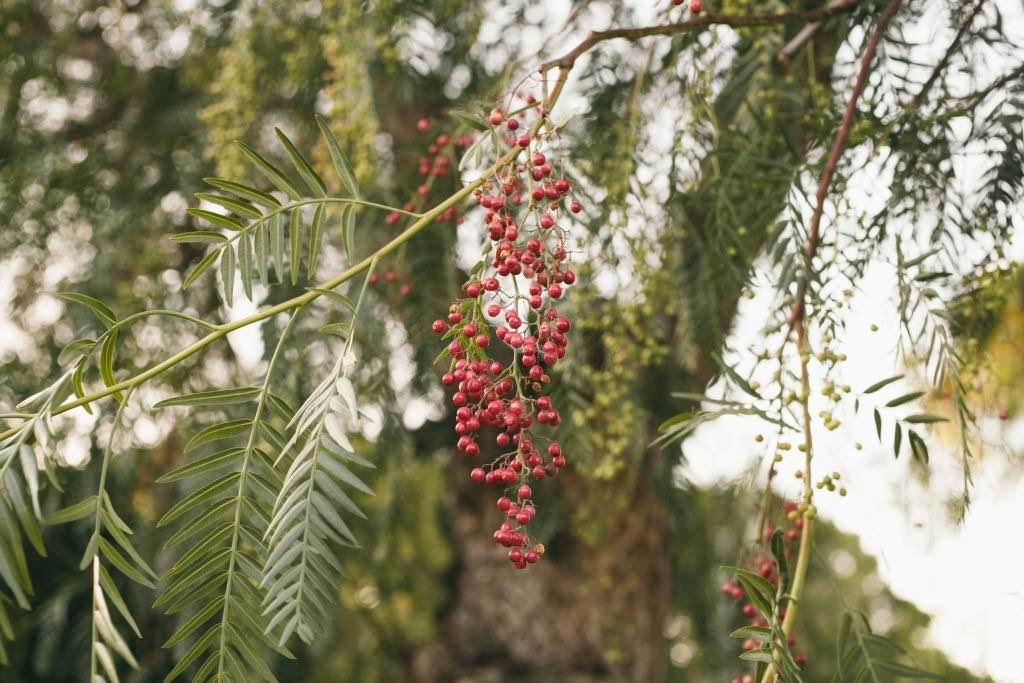
What is a California Pepper Tree?
The Schinus Molle, aka the California Pepper Tree, boasts bright pink berries with loose-hanging branches and feathery foliage; it’s a popular choice for many. As a Mediterranean-style tree that’s also quick to grow, it can reach a mature height of around 12 meters tall. Its branches are known to grow as wide as the tree reaches in height.
During the Springtime, whitish-green flowers start to form at the end of the branches. By Fall, they will have transformed into rose-pink-hued berries. When a California Pepper Tree is still in its infancy, it will have a grayish-colored trunk; as they age and mature, the bark of the tree will peel back to show a wonderfully red color of the wood.
Things to Know About Growing California Pepper Trees
If you’re considering growing a California Pepper Tree, it’s important to ensure you have the right amount of space to allow the tree to spread to its fully-sized self.
Remember, these trees can grow as tall as 40-feet (12 meters).
Well-drained soil is also important, along with finding a spot for it to grow that is in direct sunlight.
If you aren’t able to pick a site with the right conditions and the soil drains poorly, this can significantly increase the amount of care that is required.
It’s not uncommon to see root rot pathogens attacking the tree in such conditions, so it’s important to get things right from the start if you’re serious about growing California Pepper Trees at your property.
Now, you can either grow the tree from a seed or purchase a container tree with a good-strong trunk. The latter is the easiest option. Young trees will need to have their stem tips removed and be regularly pinched to help with growth. Mature trees only require infrequent pruning to help spot any potential issues and improve their overall appearance.
We will cover how to look after and maintain a California Pepper Tree in the next section.
California Pepper Tree Maintenance
- Pruning
Pruning a California Pepper Tree is an essential element of maintenance that is required to help keep the tree healthy and looking its best. In order to properly prune this type of tree, you’ll need to ensure that any diseased or dead limbs are cut away, all the way back to the trunk. Younger trees will require a greater frequency of pruning compared to mature trees. Winter is usually the best time of year to prune California Pepper Trees as the tree is not actively growing at this time.
Once a tree matures, you only need to prune them once every winter to try and keep a high canopy. These trees are prone to weeping, and this can lead to the canopy appearing to be quite low on the ground. Another important thing to watch out for is suckers that can sprout out from the base of the tree. If spotted, these should be immediately pruned out as soon as they appear.
If you’re trimming a California Pepper Tree yourself, follow these steps.
- Make sure you trim any dead twigs away at the joint of the tree’s branches.
- Remove any diseased or dead branches, either with loppers or a pruning saw. Be sure to cut the branches right the way back to the sprouting limb.
- If you’re trimming a mature tree, then there’s no harm in cutting back wayward leaves to keep things neat. They have a naturally bushy appearance, so this is normal and expected in order to prevent their droopiness from getting in the way.
At Pacific Landscaping, we can help you keep your gardens and trees in top condition. From regular tree maintenance to annual tree trimming services. Call us today to speak with a member of our friendly team, ask us any questions, arrange a visit, or get a quick quote.
Common California Pepper Tree Problems
With their weepy-like appearance, berries, flowers, and delicate leaflets, they offer dense areas of shade, which can be a real benefit in our climate. However, they aren’t without their issues.
- Debris
California Pepper Trees can produce a lot of debris; when you consider their clusters of flowers and their berries, not to mention the branches that frequently break away, there can be a lot to tidy up after. Female variants produce berries twice annually, and this can result in the need to clear out yards and clean cars regularly.
- Invasive Lists
In some states, California Pepper Trees appear on invasive lists. This means they have a tendency to destroy local habitats by crowding-out the native plants, making it harder for the animals that depend on these habitats for their survival. These listings can, in certain states, mean that it is unlawful to grow or own the plant. The spread of Pepper trees is compounded when small mammals and birds eat the tree’s berries and spread the seeds.
- Toxicity
In some people, the pretty leaflets of the California Pepper Tree have been known to cause allergic skin reactions. The Pepper trees belong to the same family as the Poison Oak, the Anacardiaceous Family. While this is incredibly rare, if you have someone with known sensitivities or who is prone to allergic skin reactions, there could be a better choice of tree for your family home.
- Troublesome Root Systems
The roots of a California Pepper Tree will go anywhere and everywhere in their search for nutrients and water. While this can make the tree naturally drought tolerant, it can also be somewhat problematic. The surface roots of the tree make it virtually impossible for anyone to grow anything underneath the tree. In addition to this, the aggressive nature of the roots can invade drains, sewers and even lead to broken pavements,
California Pepper Tree FAQs
Here are some of the questions we’ve seen being asked about California Pepper Trees.
Can you eat the berries of a California Pepper Tree?
I was looking up the pink pepper and got to know there are TWO types of pink pepper – a) Peruvian pink pepper tree (Schinus molle) are considered safe to eat. B) Brazilian pink pepper tree (Schinus terebinthifolius) berries are generally not considered to be safe for eating.
— 𝐒𝐫𝐢𝐝𝐡𝐚𝐫 (@uxgravy) May 29, 2020
People do eat the berries of the California Pepper Tree.
However, they are usually roasted or dried first.
They have been known to be used as a spice substitute and have also been used to make oils and spice that are used in candy and other baked products.
How do you kill a California pepper tree?
Although there are various chemical treatments that are said to get rid of the California Pepper Tree, it’s important you consult with a local landscaping professional in the very first instance. They will be able to assess things such as the spread of the roots, the age of the tree and ascertain the best way to fully remove it.
Can you grow anything under a California Pepper Tree?
Because they are shade trees by nature, if you want to grow anything underneath a California Pepper Tree, then you’ll need to make sure it’s a plant that can survive in dry soil and under shade. Bergenia, Lamium, Epimedium, Lunaria, Sarcococcoa, Polypodium, Dicentra, or Vinca minor are all good options.
At Pacific Landscaping, our team of professional tree service experts is here to help you in any way we can. From tree trimming services through to outdoor landscaping, contact us today for an initial chat about how we can help you.



